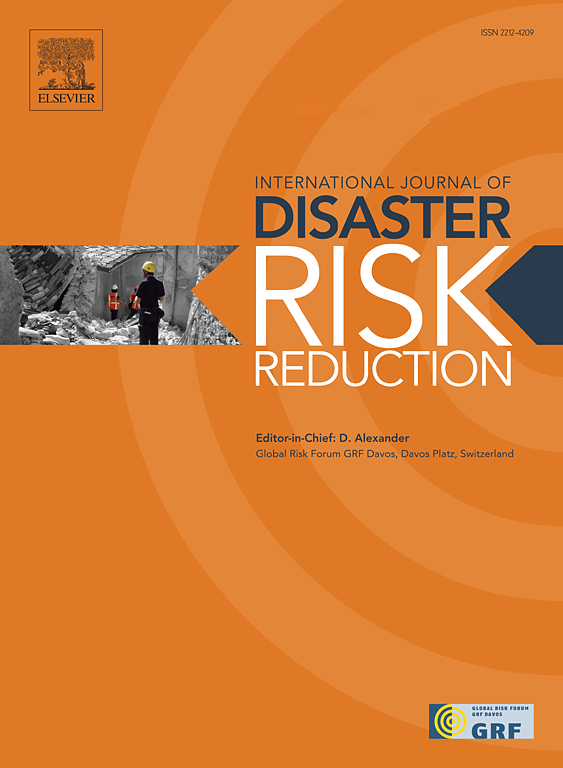2021年阿瑞丹谷(加那利群岛拉帕尔马)火山爆发后,灾后新自由主义规划的胜利
IF 4.2
1区 地球科学
Q1 GEOSCIENCES, MULTIDISCIPLINARY
International journal of disaster risk reduction
Pub Date : 2025-04-16
DOI:10.1016/j.ijdrr.2025.105490
引用次数: 0
摘要
2021年拉帕尔马岛(西班牙加那利群岛)的火山爆发表明,现有的空间规划无法减少脆弱性。这也为改变人们对火山风险的看法打开了一扇机会之窗,因为需要制定具体的空间规划立法来解决阿瑞丹河谷的恢复和重建问题。然而,在火山爆发三年多后,新的空间规划标准最终被采纳,却没有考虑到与火山有关的危害。这是一项研究的主要结论,该研究基于对阿里达内山谷空间规划过程中产生的文件的研究,对该过程中关键角色的半结构化采访以及对当地媒体的分析。这也表明,在地方政府换届后,最初限制在火山风险最大的地区定居、减少人口分散的想法被放弃了。新政策制定者和他们的竞选活动中占主导地位的新自由主义城市主义方法,加上那些失去财产的当地人普遍的短期愿景,导致了灾后火山风险治理的严重失败。这使得当地社会的后代在进一步爆发时更加脆弱。因此,案例研究再次证实,社会、经济和政治因素如何与理解与极端自然事件相关的灾难的严重程度高度相关。本文章由计算机程序翻译,如有差异,请以英文原文为准。
The triumph of post-disaster neoliberal planning after the 2021 volcanic eruption in Valle de Aridane (La Palma, Canary Islands)
The 2021 volcanic eruption on the island of La Palma (Canary Islands, Spain) demonstrated how existing spatial planning was unable to reduce vulnerability. It also opened up a window of opportunity to change volcanic risk perceptions since specific spatial planning legislation was needed to tackle the recovery and reconstruction of Valle de Aridane. However, more than three years after the start of the eruption, new spatial planning criteria finally adopted failed to take into account the hazards associated with a volcano. This is the main conclusion of a research based on the study of the documentation generated during the spatial planning process in the Valle de Aridane, semi-structured interviews with key actors in the process and the analysis of the local media. It also shows that the original idea of restricting settlement in the areas of greatest volcanic risk and reducing the dispersion of the population was abandoned after a change in the regional government. The dominant neo-liberal urbanism approach among new policy makers and their electioneering, coupled with the prevailing short-term vision of those locals who lost their properties, have led to serious failures in the governance of post-disaster volcanic risk. This perpetuates the vulnerability of future generations of local society to further eruptions. The case study therefore confirms how, once again, social, economic and political factors are highly relevant to understanding the magnitude of catastrophes associated with extreme natural events.
求助全文
通过发布文献求助,成功后即可免费获取论文全文。
去求助
来源期刊

International journal of disaster risk reduction
GEOSCIENCES, MULTIDISCIPLINARYMETEOROLOGY-METEOROLOGY & ATMOSPHERIC SCIENCES
CiteScore
8.70
自引率
18.00%
发文量
688
审稿时长
79 days
期刊介绍:
The International Journal of Disaster Risk Reduction (IJDRR) is the journal for researchers, policymakers and practitioners across diverse disciplines: earth sciences and their implications; environmental sciences; engineering; urban studies; geography; and the social sciences. IJDRR publishes fundamental and applied research, critical reviews, policy papers and case studies with a particular focus on multi-disciplinary research that aims to reduce the impact of natural, technological, social and intentional disasters. IJDRR stimulates exchange of ideas and knowledge transfer on disaster research, mitigation, adaptation, prevention and risk reduction at all geographical scales: local, national and international.
Key topics:-
-multifaceted disaster and cascading disasters
-the development of disaster risk reduction strategies and techniques
-discussion and development of effective warning and educational systems for risk management at all levels
-disasters associated with climate change
-vulnerability analysis and vulnerability trends
-emerging risks
-resilience against disasters.
The journal particularly encourages papers that approach risk from a multi-disciplinary perspective.
 求助内容:
求助内容: 应助结果提醒方式:
应助结果提醒方式:


